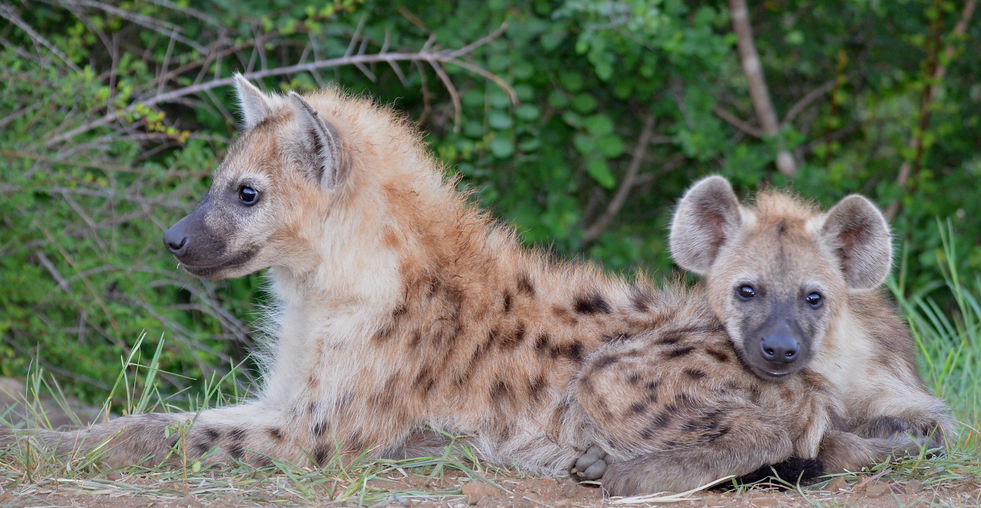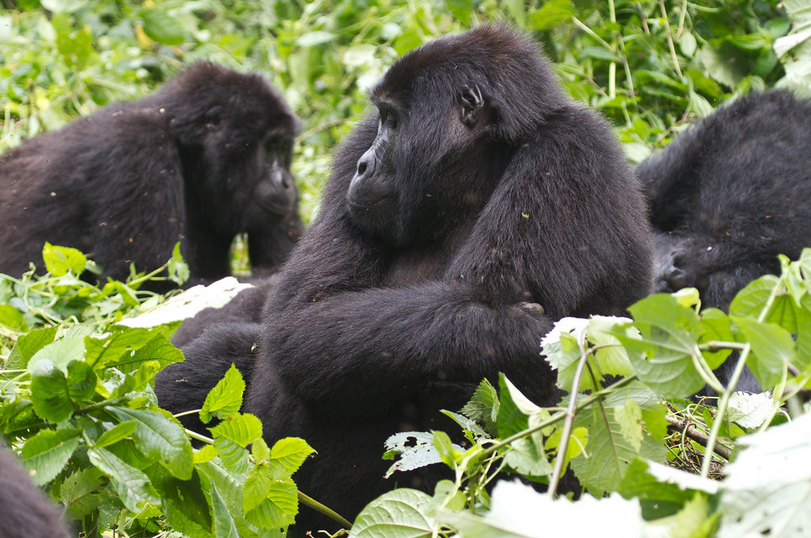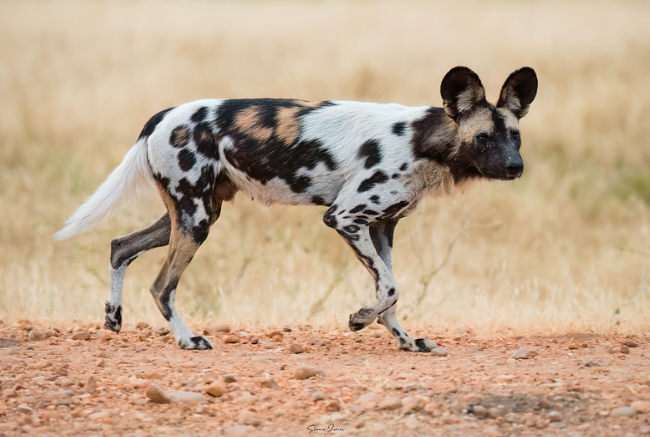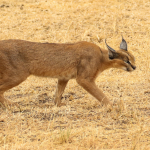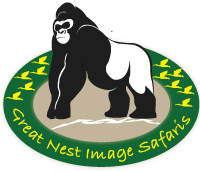The Spotted Hyena (Crocuta crocuta)
The Spotted Hyena (Crocuta crocuta) : also known as the laughing hyena is a specie classed as the sole extant member of the genus Crocuta. It is a native to the Sub-Saharan Africa in countries like Uganda, Ghana, Zambia, Malawi, etc. This spotted hyena is the most social of the carnivores which is the largest group sizes and with most complex social behaviors. Different from other species, the social system of the spotted hyena is openly competitive other than cooperative. Interestingly, females care and provide only for their own clubs rather than assisting each other.
On the other hand, males display no paternal care and their societies are larger than males and dominate them. Being the most common large carnivore in Africa, the spotted hyena is a greatly successful animal due to its part adaptability and opportunism. The species is primarily a hunter but at times it’s a savage with the capacity to eat and digest a bone, skin, and other animal wastes. Basically, these animals hunt alone, in small groups of 2-5 members or in large groups. During a hunt, they often run through ungulate herds in order to select an individual to attack. Once selected, their prey is chased over a long distance often several kilometers.
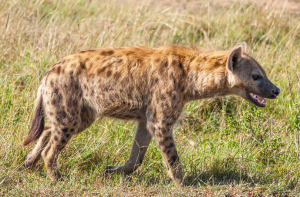
Physical Appearance
The spotted hyena has a strong and well developed neck including forequarters, but relatively underdeveloped behind parts. In addition, the rump is round instead of rectangular which prevent attackers coming from getting a grip on it. Their fur also varies greatly and always changes with age and it is made up of spots, and much shorter. Furthermore, the base color is usually pale greyish-brown or the vice versa. Whereby an irregular pattern of roundish spots is superimposed on the hind and back quarters. The spots vary in size, even on single individuals and their variable distinction may be reddish, blackish or almost deep brown.
A less distinct spot pattern is visible on the legs and belly but not on the throat and chest. However, some made research confirms that at times the spot patterns help to identify out individual hyenas. The crest is usually reddish-brown in color, the crown and upper part of the face is brownish including a white band above both eyes. The area around the rhinarium, the lips and the back portion of the chin are all blackish. Besides, the limbs are spotted, though the feet vary in color ranging from light brown to blackish. The mammal has appropriately a large heart, nearly to 1% of its body weight thus giving it great endurance in long chases. This spotted hyena’s skull has a much greater size and narrower sagittal crests. Due to its size, it has one of the most powerful built skulls among the Carnivores.
Behavior
Spotted hyenas form social groups namely clans and these may comprise of 3 to 80 members. These large clans usually occur in prime territory with large prey concentrations, such as Kidepo valley national park. On the other hand, smaller clans occur in the desert areas in southern Africa. Here, all females are dominant to all males and they remain in their natal clans for the rest of their life. Males scatter or disperse upon reaching sexual maturity and once a male joins another clan, he enters a dominance line up that the other males respect.
Males spend quite a long time on developing relationships with females in the clan. In fact, they follow females for periods of days or weeks and eventually gain favor with the females through this behavior. Even though these hyenas live in clans, the members of a clan are only observed all together in three circumstances. These include; when defending the territory, at communal den as well as during kills. Sometimes the clan members forage alone or in small groups. However, higher ranking females have been shown to combine more with kin than low ranking females.
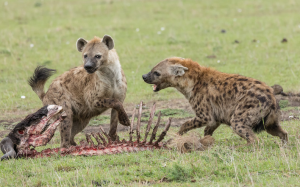
Hunting Behavior
Leaving alone other large African carnivores, spotted hyenas do not normally prey on any species. When hunting medium to large sized prey, they tend to select certain animal categories. These include; the young animals that are frequently targeted as well as the old ones. The usually spot and tracks live prey by sight, smell and hearing. However, carrion is normally detected by smell and the sound of other animals or predators feeding. Their auditory perception is powerful in that it can detect sounds of predators killing prey or feeding on carcasses over a quite distance. The hyena relies more on sight than smell when hunting and does not follow its prey’s prints. Besides, small prey is killed by being shaken in the mouth whilst large prey is eaten alive.
Denning Behavior
Basically, in these animals, the clan’s social life revolves or rotates around a communal den. Some clans tend to use particular den sites for years while others may use several different dens within a year or simultaneously. These dens consist of more than a dozen entrances and are normally located on flat grounds. Their tunnels oval in section, being wider they are high and narrow down from an entrance. Dens have large bare patches around their entrances where hyenas move or lie down on.
Because of their size, adult hyenas are incapable of using the full extent of their burrows, since most tunnels are dug by cubs or smaller animals. These hyenas rarely dig their own dens, having been observed for the most part to use the abandoned burrows of different animals like warthogs, jackals, hares, etc. Faeces are normally deposited 20 metres (66 feet) away from the den. However, they urinate wherever they happen to be. Dens are used mainly by several females at once, whereby it is not uncommon to see up to 2 metres in width, the height being rather less.
Reproduction
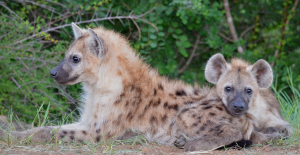
Reproduction in spotted hyenas is polygamous and they are non-seasonal breeder however a birth peak occurs during the wet season. As a matter of fact, females are polyestrous, with an estrus period lasting nearly two weeks. This animals is promiscuous and no enduring pair bonds are formed. In any case, both sexes may copulate with several mates over the course for several years. Male spotted hyenas will display or show submissive behavior when approaching females in heat.
Even if the male over weighs or outweighs his partner, it normally favors younger males born or joined into the clan. Males perform a bowing display to females before mating and lowers his muzzle to the ground. He later, advances quickly towards the female, bows again and then paws the ground close at the hind quarters of the female. The female’s dominance assures that males are timid and will retreat immediately if the female displays any aggression. The gestation period is 4 months and females usually bear twins although 1 to 4 young are possible. The females give birth through their penis-like clitoris and during birth the clitoris ruptures.
This basically allows the young to pass through and the resulting wounds take several weeks to heal. Cubs are not weaned until they are between 14 and 18 months of age and females are capable of producing a litter every 11 to 21 months. The newborn cubs weigh nearly from 1 to 1.6kg and are normally quite precocious being born with their eyes open. The age at sexual maturity is about three years, although some males may be sexually active at the age of two. Females are very protective of their young and do not tolerate other hyenas around their babies. Interestingly, males have not been reported to have any role in parental care.
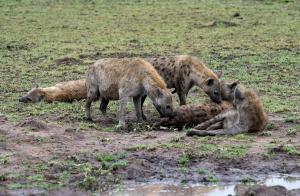
Communication
The hyena is well known for its wide variety of vocal communication. Some of these include; groans and soft squeals that are uttered during hyena greetings. A whoop is given out as a contact call whereby a fast whoop is uttered when excited at a kill. Usually males give the fast whoop calls often than the females but are generally ignored. However, female calls generally evoke much more of a reaction.
Additionally a lowing call is used by impatient hyenas who are always kept waiting at a kill. Spotted hyenas also possess a complex set of postures in communication, like when threatened or afraid. Here, the ears are folded flat, and are usually followed with baring of the teeth and flattening of the mane. During any attack by either wild dogs or other hyenas, it lowers its hindquarters. During an allegation attack, the head is held high with the ears cocked, mouth closed, mane erect and the hindquarters high. The tail normally hangs down when neutral, though it changes position according to the situation.
Feeding
The spotted hyena is the most carnivorous member of the Hyaenidae and have a reputation for being mostly scavengers. However, this is not accurate since a study revealed 70% of the diet was composed of direct kills. Generally clans split up into hunting groups of 2 to 5 individuals and they eat a variety of items. These include; waterbucks, impalas, warthogs, topi, elands, hares, jackals not to mention but a few. Hyenas use their keen senses of hearing, sight and smell to hunt live prey and at times, it chases its prey for a long distance. Although they are aggressive towards each other when feeding, they compete frequently through speed of eating other than fighting each other as lions do. In addition, they also hunt in regions of higher concentrations of prey. They do not require much water instead they normally spend approximately 30 seconds drinking.
Where to find them in Uganda
In Uganda the spotted hyena can be spotted during game drives in different national parks. These include; Murchison falls national park, Kidepo valley national park, Queen Elizabeth national park and more.

